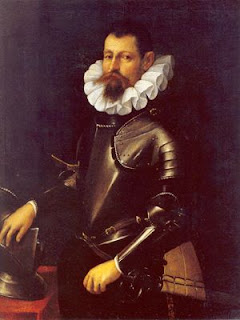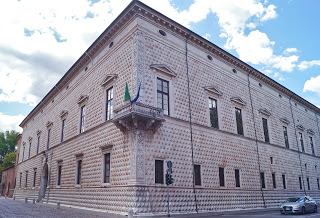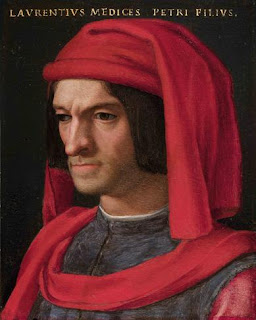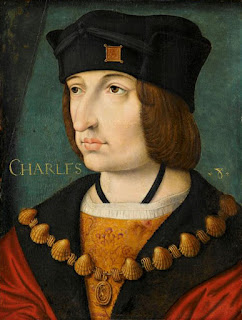Medici rival at heart of Pazzi Conspiracy
The banker Francesco de’ Pazzi, a central figure in the Pazzi Conspiracy that sought to overthrow the Medici family as the rulers of Florence, was born on this day in 1444.
The moment at which Giuliano de' Medici is killed,
imagined by 19th century painter Stefano Ussi
De’ Pazzi killed Giuliano de’ Medici, stabbing him to death during mass at the Florence Duomo as the conspirators attempted to seize control.
But Giuliano’s brother, Lorenzo the Magnificent, with whom he was joint ruler, escaped with only minor wounds.
Simultaneously, other conspirators rode into the Piazza della Signoria declaring themselves the liberators of the city. But the people of Florence were loyal to the Medicis and attacked them.
Within hours, despite Lorenzo appealing for calm, an angry mob determined to exact revenge had hunted down and killed more than 30 conspirators or suspected conspirators, including Francesco.
One of nine children born to Antonio de’ Pazzi and Nicolosa, daughter of Alessandro degli Alessandri, Francesco was an important figure in the Pazzi banking business, having been appointed papal treasurer.
 |
| Sandro Botticelli's portrait of the ill-fated Giuliano de' Medici |
The administration of the papal finances was a coveted prize for any banking family and Pope Sixtus IV’s decision to take responsibility away from the Medici Bank in favour of the Pazzi antagonised Lorenzo in particular.
Sixtus IV, from a poor bacground originally, was determined to enrich both his own Della Rovere family and their cousins, the Riario family. He had designs on the rich Florentine territories for the benefit of his nephews, including the nobleman Girolamo Riario, and also to finance the expensive works undertaken by him in Rome.
The rift between Rome and the Medicis occurred when Galeazzo Maria Sforza, the Duke of Milan, changed his mind about selling the town of Imola, which occupied a strategic position on the trade route between Florence and Venice, to Lorenzo de’ Medici in favour of a deal with Sixtus IV, provided that Sixtus agreed to the marriage of his daughter, Caterina Sforza, to Girolamo Riario.
Lorenzo, as Sforza’s banker, refused to finance the deal, not wishing to see an extension of the papal states, at which Sixtus turned to the Pazzis and handed the contract for the papal treasury to them.
There were suspicions that the Pazzi Conspiracy was actually conceived in Rome but the Pazzi had reasons of their own to turn against the Medici, not least the decision of Lorenzo to introduce a law that prevented a considerable sum of money flowing into the Pazzi coffers with the death of Giovanni Borromei, the very wealthy father in law of Giovanni de’ Pazzi, another of Francesco’s brothers.
 |
| Da Vinci's drawing of Bandini's hanging |
A further source of friction between Lorenzo and the Pazzi was his appointment of Lorenzo's brother-in-law Rinaldo Orsini as Archbishop of Florence in succession to the late Pietro Riario in 1474. The candidates overlooked included Francesco Salviati, a relative of the Pazzi family and friend of Francesco.
Whatever its origins, it is generally accepted that the chief conspirators in the Pazzi Conspiracy were Girolamo Riario, Francesco de' Pazzi and Francesco Salviati, the trio who attacked Lorenzo and Giuliano in the Florence duomo, the magnificent Cathedral of Santa Maria del Fiore, on the morning of April 26, 1478.
Giuliano was assassinated by Francesco de' Pazzi together with Bernardo Bandini di Baroncelli, suffering a sword wound to the head as well as being stabbed 19 times. Lorenzo was attacked by two of Jacopo Pazzi's men, but managed to escape.
Salviati then took a number of Jacopo Pazzi's men to the Piazza della Signoria hoping to be received by the Florentine populace as liberators. Instead, they were attacked. Along with Francesco de' Pazzi and several others, Salviati was hanged from the windows of the Palazzo Vecchio.
More than 30 suspected conspirators were caught and killed within hours of the attack and over the course of the next eight months some 50 more were captured and executed, including Bandini dei Baroncelli, who had escaped to Constantinople but was arrested and returned, to be hanged from a window of the Palazzo del Capitano del Popolo while still dressed in Turkish clothing.
Jacopo de' Pazzi, head of the family, escaped from Florence but was caught and brought back to be tortured and then hanged from the Palazzo della Signoria next to the decomposing corpse of Salviati.
All other members of the Pazzi family were banished from Florence, and their lands and property confiscated. The family name was erased from public registers, while all buildings and streets carrying it were renamed. Anyone named Pazzi had to take a new name; anyone married to a Pazzi was barred from public office.
Travel tip:
The Palazzo Vecchio guards
over Piazza della Signoria
The Piazza della Signoria has been the focal point of the city of Florence since the 14th century. Overlooked by the imposing Palazzo Vecchio, it was the scene of the triumphant return of the Medici family in 1530, three and a half decades after they had been driven from the city by the supporters of the fanatical priest, Girolamo Savonarola. The controversial cleric's famous bonfires of the vanities were built in the middle of the square. The piazza della Signoria contains several important sculptures and statues, including a copy of Michelangelo's David - the original is in the Galleria dell'Accademia - Baccio Bandinelli's Hercules and Cacus, Bartolomeo Ammannati’s Fontana del Nettuno and Benvenuto Cellini’s statue of Perseo holding Medusa's head.
Travel tip:
The Cattedrale di Santa Maria del Fiore is the
dominant feature of the Florence skyline
The Florence duomo - the Cattedrale di Santa Maria del Fiore - with its enormous dome by Filippo Brunelleschi and campanile by Giotto, is one of Italy's most recognisable and most photographed sights, towering above the city and the dominant feature of almost every cityscape. From groundbreaking to consecration, the project took 140 years to complete and involved a series of architects. Arnolfo di Cambio, who also designed the church of Santa Croce and the Palazzo Vecchio, was the original architect. When he died in 1410, 14 years after the first stone was laid, he was succeeded by Giotto, who himself died in 1337, after which his assistant Andrea Pisano took up the project. Pisano died in 1348, as the Black Death swept Europe, and a succession of architects followed, culminating in Brunelleschi, who won a competition to build the dome, which remains the largest brick-built dome ever constructed.
Also on this day:
1453: The birth of Renaissance beauty Simonetta Vespucci
1608: The birth of physiologist and physicist Giovanni Alfonso Borelli
1813: The birth of scientist Paolo Gorini
1969: The birth of world champion swimmer Giorgio Lamberti
1978: The birth of goalkeeper Gianluigi Buffon































